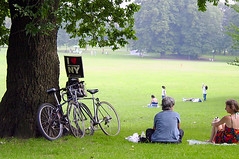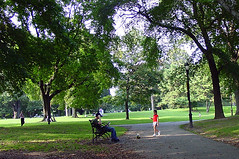The drumbeat for selling off school property is getting louder and louder
As one entered Hall D for the Citizen Summit, a number of government agencies, and some other intrepid folk had booths.
One of the indefatigable presenters was Mary Rowse of Historic Washington Architecture, which took the opportunity to get more supporters for saving the Jesse Baltimore House--a house that the DC Parks and Recreation Dept. is happy to tear down for a bit of green space, even though it is the last house in a row of houses, and would be worth upwards of $700,000 if the house could be extricated from DC Government possession (technically it's owned by the National Park Service) and sold to someone who would actually take care of it.
The demolisher instincts are abetted by Councilmember Patterson's pandering to a handful of neighborhood residents who figure it's better to tear down the building than to count on DC Government actually taking care of the property (see this link for more info).
 The actual house in the Palisades is on the right. A photo, from the Sears House Catalog, of a model "Fullerton" kit-built house is on the left. Image by Peter Sefton.
The actual house in the Palisades is on the right. A photo, from the Sears House Catalog, of a model "Fullerton" kit-built house is on the left. Image by Peter Sefton.But I digress...
I talked with a government official and one of the things we talked about was the whole "Strategic Neighborhood Action Plan" planning process, back in 2001. I said that I was disappointed from the outset with this process--which was piloted in my neighborhood, so I guess I was one of the first people to be involved with SNAPs--because it didn't deal with or address foundational questions of what is a good neighborhood and why, what are the amenities that quality neighborhoods possess, etc. I felt that we were forced to operate with very severe blinders that overly narrowed our participation.
12 Principles of a Walkable Community -- are as good a place to start as any...
1. Intact town centers.
2. Residential densities, mixed income, mixed use.
3. Public Space.
4. Universal Design
5. Key Streets Are Speed Controlled.
6. Streets, Trails are Well Linked.
7. Design is Properly Scaled to 1/8th, 1/4 and 1/2 mile radius segments.
8. Town is Designed for People.
9. Town is Thinking Small.
10. In Walkable Communities There Are Many People Walking.
11. The Town and Neighborhoods have a Vision.*
12. Decision Makers Are Visionary, Communicative, and Forward Thinking.
He said he deals with the fallout from this, that most wards and neighborhoods don't really have good plans to work with...
I raise this because it is relevant to the People's Property Campaign, being coordinated by EmpowerDC, that I have mentioned from time to time. For a property to be declared "surplus" by the DC Government, it must be determined that there is "no further public use" for the property.
But there is no comprehensive process to determine if there are alternative public uses, or whether or not a neighborhood has a full complement of the municipal amenities and services necessary to create and maintain stable, livable, healthy communities.
For example, I am extremely bothered by the fact that right now we have at least four simultaneous but somewhat disconnected planning processes going on--the Comprehensive Plan revision, the DC Public Schools planning process, the DC Public Library planning process, and the DC Dept. of Parks and Recreation planning process.
The Comprehensive Plan effort is a somewhat bastardized process primarily concerned with land use, but also some "broader" issues such as "arts and culture."
The reality is that there is no "Comprehensive Plan" for the city, a plan that takes into account all quality of life and economic development vectors that should concern us.
This is relevant when reading Washington Post columnist Marc Fisher's column today "Fix Up Schools, But Not With Faulty System." In the column he makes a good point that it seems somewhat foolish to entrust $1 billion for school renovation and reconstruction to a school system that hasn't proven its ability to engage in such activities. But I also see him slobbering in favor of wanton privatization of public assets in his second to last paragraph:
Closing a few dozen schools could boost Mayor Tony Williams's plan to lure 100,000 new residents. Many schools sit on land that makes developers salivate. Developers are so hungry for land in every ward, they'd happily build new schools, free of charge. Doubt it? We just witnessed a wild bidding war for one of the city's most crime-ridden housing projects, Sursum Corda. The money is falling from trees.
School sites are just some of the public assets that belong to residents of the District of Columbia. Before we go off wantonly selling these properties, ought we not determine what other use such assets could perform in helping us to maintain and extend the quality of life in our city?
Because the Washington Post is so associated with the developer agenda, you do have to wonder about statements like that of Mr. Fisher...
In my conversation with that DC government official, he said that 100 years ago, say during the time of the McMillan Commission, urban planning was much different, that it was about quality of life, that today it is about economic development and fiscal realities.
I said two things to him. First, I said that earlier in the week I was in Manhattan and Brooklyn and that probably everyone who lives in either of those boroughs would prefer to live immediately adjacent to Central Park or Prospect Park.
Second, that it is "common knowledge" that houses in places with good schools, parks, and libraries are valued more highly than houses in neighborhoods lacking those amenities. For example, houses in Montgomery County in the geographies of the most successful high schools such as Walt Whitman or Richard Montgomery, cost much more than equivalent houses in areas where the high schools are less successful.
Frederick Law Olmsted wrote about this more than 120 years ago, in a letter to City of Boston officials, in pushing forward plans for new public parks. He wrote specifically about the value such parks provide and how adjoining land rises in value, and therefore, generates more property tax revenues.

 Prospect Park, Brooklyn. Photos: www.citying.com
Prospect Park, Brooklyn. Photos: www.citying.com_____________________
* From "How Can I Find and Help Build a Walkable Community"
11. The Town and Neighborhoods have a Vision. Seattle, Washington, Portland, Oregon and Austin, Texas are just three examples where neighborhood master plans have been developed. Honolulu sets aside about $1M per year of funds to be spent by each neighborhood. Visionary, master plans provide direction, build ownership of citizens, engage diverse people, and create opportunities for implementation, to get past sticky issues, and deal with the most basic, fundamental, necessary decisions and commitment. There are budgets set aside for neighborhoods, for sidewalks, trails, links, parks. The community no longer talks about where they will get the money, but how they will change their priorities.



0 Comments:
Post a Comment
<< Home